
H.O. +91 9828550167

Salasar town is a part of district Churu in Rajasthan and it is situated on the Jaipur - Bikaner highway. It is at a distance of 57 kilometers from Sikar, 24 kilometers from Sujangarh and 30 kilometers from Laxmangarh. Salasar town lies under the jurisdiction of the Sujangarh Panchayat Samiti and is well connected with Delhi, Jaipur and Bikaner by regular bus service run by the Rajasthan State Road Transport Committee. Indian Airlines and Jet Air fly to Jaipur, from where Salasar is 3.5 hours drive via a taxi or a bus. Sujangarh, Sikar, Didwana, Jaipur and Ratangarh are the nearest railheads for Salasar Balaji. This city is about 170 kilometers from the city of Pilani that hosts the Birla Institute of Technology and Science. The road from Delhi to Bold textPilani is very good and Balaji is often accessed via that route by people approaching from the direction of Delhi.
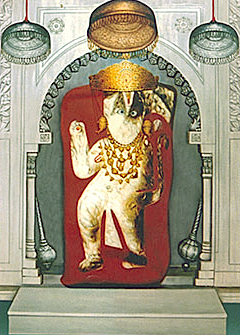
Balaji temple at Mehandipur in Rajasthan is very Powerful place. It is believed that the deity in this temple has divine power to cure a person possessed with evil spirit.Hundreds of 'Sankatwalas', as the possessed people are refereed to in local lingo, throng to the temple everyday to offer prayers and have 'darshan'. The temple has also become a home and the last respite for the victims.The 'Mahant' of the temple, Shri Kishor Puri Ji, prescribes the treatment. It can include reading holy texts, following a strict vegetarian and simple diet, and even afflicts physical pain to one's body.
One can witness people going through various physical therapies like keeping heavy stones on their body , on arms, legs and chest , to ease their pain. There are others who inhale the smoke that fumes out of the sweet Patasa's kept on smoldering cowpats. The ones with serious case of spirit possession, who tends to get violent, are even shackled in chains within the temple premises.
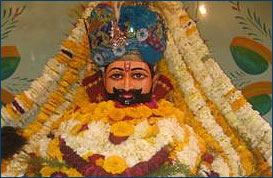
The battle of Mahabharata was inevitable between the Pandavas and Kauravas, and having got the news, Barbareek wanted to witness the great war. He promised to his mother, that if he felt the urge, to participate in the battle, he would join the side which would be losing. He rode on the Blue Horse (Leela Ghora) equipped with the three arrows and the bow. The omnipresent Lord Krishna, disguising himself as a Brahmin, stopped Barbareek to examine his strength. He even tried to mock Barbareek saying that he was going to the great battle with only three arrows.
On this, Barbareek replied that only one arrow was enough to destroy all the enemies in the war, and it would then return to his quiver. If all the three were used, it would create havoc in the three worlds. Lord Krishna challenged him to tie all the leaves of the peepal tree under which he was standing, with one arrow. Barbareekaccepted the challenge, removed one arrow from his quiver and released it from his bow.
The arrow tied all the leaves together within moments. But Lord Krishnahad one leaf under his foot. The arrow then started revolving around his foot, and he asked the boy, whom would he favour in the war. Barbareek reiterated that he would fight for the side which loses. Lord Krishna knew that defeat of Kauravas was inevitable, and if this vrave boy joins them, the result would be in their favour.
The Brahmin (Lord Krishna) then wanted charity from the boy. Barbareek promised him anything he wished. Lord Krishna asked him to give his head in charity. The boy was shocked, but he maintained his promise. He requested the Brahmin to disclose his identity. Lord Krishna showed him his divine form.
He explained to Barbareek that before the battle, in order to worship the battlefield, head of the bravest Kshatriya needs to be sacrificed. And he considered Barbareek to be the bravest, and hence asked for his head in charity.
Barbareek requested that he wanted to see the battle till its end, and his wish was granted. Thus on the12th day of Shukla Paksha of Falgun month, he gave his head to Lord Krishna (SHISH DAAN). The head was placed atop a hill near the battlefield from where, Barbareek could watch the whole battle.
When the battle was over and Pandavas having won, they argued amongst themselves as who was responsible for victory. At this, Lord Krishna suggested that Barbareek's head had watched the whole battle, and who else would be a better judge. Barbareek's head suggested that it was Lord Krishna who was responsible for the victory, his advice, his presence, his gameplan had been crucial. He could see only the Sudarshan Chakra revolving around the battlefield which was hacking the Kaurava army to pieces and Draupadi assuming the fearful form of Mahakali Durga was drinking bowl after bowl of blood and was not allowing even one drop of blood to fall on the earth.
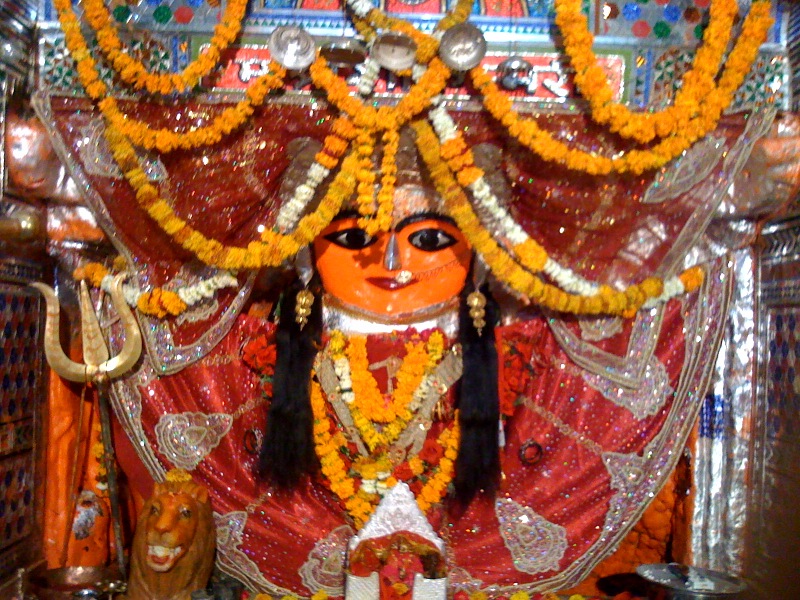
The Demon Durgam had acquired all the four books of total knowledge (The Veda) from Lord Brahma through penance. He also gets a boon from Lord Brahma that makes sure that all the pujas, yajnas and havis being offered to the Gods reach him instead making him invincible.
Durgam became very arrogant and started tormenting the whole world. As the consequence, it did not rain for one hundred years and the whole world was hit by very severe drought.
The rishis and munis take refuge in the caves of the Himalayas, and meditate upon the Supreme Devi. The Goddess appeared in front of them bearing a wonderful form!She had countless number of eyes upon Her that gave Her the name SATAKSHI. She was carrying grains, cereals, vegetables, greens, fruits and other herbs - and was hence called SHAKAMBARI.
She was so moved by their plights that tears rolled down from her eyes for nine continuous days and nights. The tears took the form of a river, as the result of which the drought came to an end.
The rishis, munis and the Gods then requested that she recover the Vedas, which were in possession of Durgam. Durgam came to know that people were living happily through his messengers and immediately attacked with a large army.
The Goddess protected the frail rishis, munis, Gods and others by putting up a huge wall of fire around them, and then let Her discuss hover around it. There ensued a tremendous battle between the Devi and Durgam.
A special Pujanutsav is held on the occasion of Bhado Amavasya (no moon day). This day the temple is crowded with devotees in huge number. People from all over the country visit this place to offer their puja to Goddess Sati Devi. The most remarkable feature of this famous temple is that it does not hold any painting or statue of either female or male gods. Instead a trident depicting power and force is worshipped religiously by the followers. However one can surely find a beautiful portrait of Rani Sati in the pradhan mand. The temple consists of colorful wall paintings and is structured with white marbles.
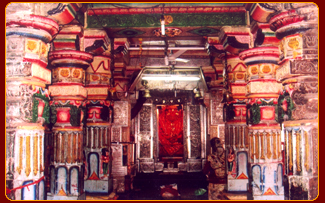
The congregation of devotees assumes a much colourful look during bi-annual Navratri celebrations - held twice a year in the solar calendar months of Chaitra(around February-March) and Ashvin(around October-November)-popularly known as the Navratris (nine holy days).
came to the thick forests of this temple during their exile from Hastinapur. The Pandavas spent part of their exile here incognito and reconstructed the mandir in the style of its present architecture. The place has acquired a great religious importance and is held sacred by all. A natural grace of serenity is lent by the lushgreen vegetation and rich flora and fauna of the surroundings.
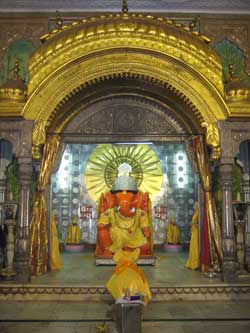
According to elderly citizens and priests of the temple, the king of Mavali (Mewar) huge idol of Lord Ganesh ji in bullock cart. He decided to build the temple wherever the bullock cart would stop first of all.
The cart stopped firstly near Moti Doongri where the temple of Lord Ganesh ji is situated at present. Then after, a business person Seth Jai Ram Paliwal took the responsibility of constructing the temple on the inspiration of Mahant (Mahant is the post of chief priest) Shiv Narain ji. The temple belongs to Shaiva sect. Shaiva sect is the followers of Lord Shiva. Shaivism is one of the oldest of the four sects of Hinduism. Shaivas, the followers of Shavisim believe that Lord Shiva is All and In All.
Lot of research is required to find out the early history of Shaiva sect, but in some of the upanishads of around 400-200 BCE the textual exposition of a systematic philosophy of Shaivism is found. During the Gupta dynasty, Shaivism spread rapidly and not limited to India but later on reached to Nepal, Sri Lanka, and few of the parts of Southeast Asia like Malaysia, Singapore, and Indonesia. Fabulous stone carving work had been done in the temple. Lattices carved in marble, and the mythological images engraved in marble are special attraction for art lovers.
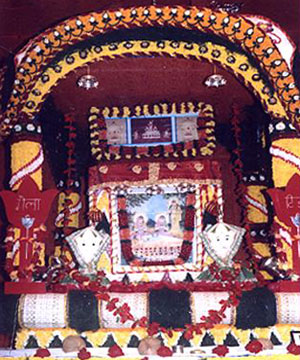
History is full of live examples of such incidences where Indian Women have created legend and acts for which they will always be remembered. The live stories of Chittaurgarh is famous for the brevity of Sati and is a burning example of the poweress of Sati.One would have read many stories of brave performances, but when we start to describe the power, strength, belief, faith and confidence of Sati Dadi ji, our neck bows down with deep regards and respect.
We have read about MahaSati Anusuiya, who converted Lord Brahma, Lord Vishnu and Lord Shankar into small children with her power and strength. We also know about Sati Savitri who because of her devotion and meditation got her husband, “Saty`avan” alive and “Yamraj” had to bow down to her wishes. Likewise there are umpteen number of examples where Indian Women have shown exemplary performances and which is being told and narrated by Grandmas to their grandchildren as fairy tales, but these are not mere stories but true fact.
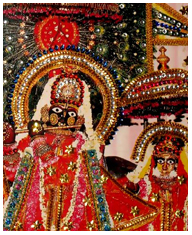
The Govind Dev Ji Temple was built in 1890 with the donation money received from Raja Man Singh. The temple is wonderfully placed between the Chandra Mahal and Badal Mahal in the City Palace complex. The Govind dev ji temple surrounded by beautiful gardens and places, this garden specially has a name Talkatora; in this garden so many attractions available for children & youngsters. Also we can say this is a romantic & peaceful garden.
Jaipur-based structural engineering firm – N M Roof Designers (NMRD) Ltd - has shot into in the Guinness World Records for designing and Constructing a Satsang Hall within the Govind Devji’s Temple in Jaipur, this has reinforced concrete cement (RCC) flat roof with a single span of 119 feet “If Dubai has Burj Al Hotel – the world’s tallest tower – India now has Govind Devji’s Satsang Hall in Jaipur, the world’s widest concrete building,” says Deepak Sogani, CEO, NMRD Ltd, the structural consultants and contractors for this project.
